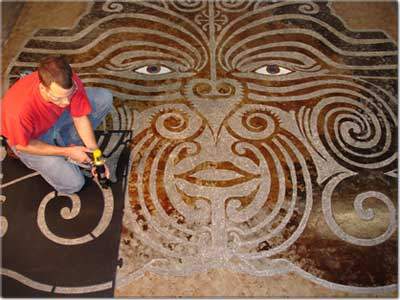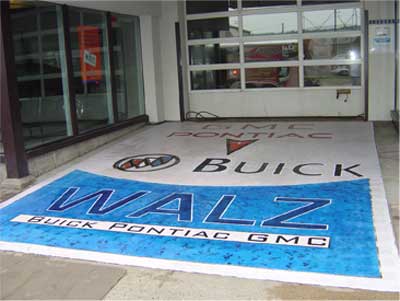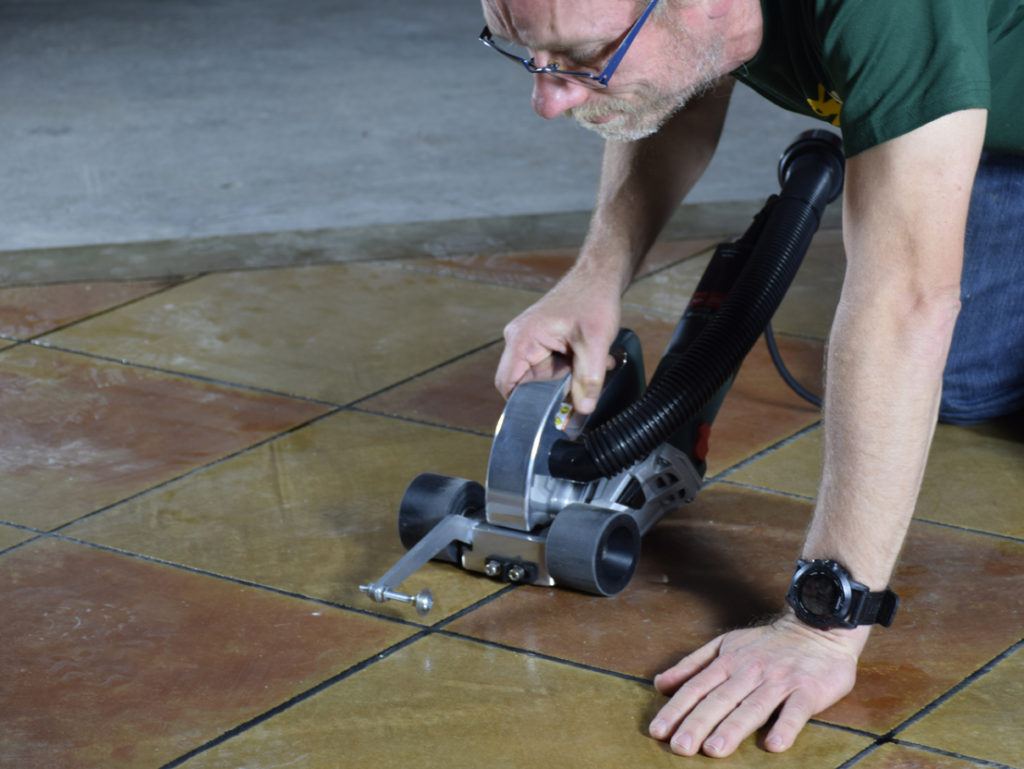Decorative Concrete Engraving – The process of turning existing, dull, gray concrete into works of art!

Nomenclature
Concrete Scoring
Simple projects by a skilled tradesman using basic tools such as a circular saw or an angle grinder with an abrasive masonry blade. Narrow kerf-1/8th inch is typical. Generally less detailed with reduced accuracy. May be dusty.
Concrete Sawing
Traditionally, sawing concrete involves crack control joints or cutting for demolition using gasoline powered equipment. Mostly used out-of-doors because of carbon monoxide emissions from the engine. The process typically requires water as a coolant. Maximum 1/8th inch wide kerfs are standard. Accurate depth control is limited. Straight unwavering lines require a highly skilled operator.
Concrete Engraving
Concrete engraving is the act of remodeling existing (cured) concrete by cutting patterns and texture into the surface. Engraved designs and patterns simulate building materials such as brick, tile, stone, pavers or a ranging variety of graphic elements. Geometric patterns with straight, circular or serpentine lines and custom designs are cut directly into the surface of the concrete. Decorative concrete engraving adds depth and dimension plus it is commonly used as a color separation technique.

Several tools have been designed specifically for or adapted for concrete engraving. Intersecting lines and graphic elements are easily controlled with precision tools which have appropriate cutters. Dust control, for many reasons is a necessity. Most engraving tools have shrouds and guards which attach to standard shop vacuums. Pneumatic tools have combination water/vacuum dust control. The bottom of the engraved area is as visually important as the surface, making accurate depth control essential. Engraved kerfs may range from very narrow to very wide, depending on the design parameters. Kerf depths are typically 1/16th, 3/32nds or 1/8th inch deep. Depth of the engraved lines can be purely aesthetic or functional. A deeper engraving is required in order to hold sufficient amounts of an epoxy or grout in the recessed area.
Concrete engraving tools, whether they are pneumatic or electric, cut the surface with various methods including: abrasive diamond blades, sand blasting, shot blasting, micro-rod impaction and reciprocating stylus. There are tools used in combination with design templates to achieve exacting graphics and artistic results. Templates can be made of a variety of materials including single use adhesive backed vinyl or reusable non-marking plastic. Engraving tools can be controlled with tracking systems to make perfect circles, arcs or straight lines or to efficiently produce patterns like brick.
Although tile patterned flooring is a common theme, engraving is used to reproduce or enlarge original artistic designs and graphics, restoration or make-over projects for vintage concrete, producing specialty logos, traffic warning symbols or textures, and thousands of patterns. Some patterns are used as decorative safety grooving.
Coloring of the cured concrete surface before engraving is typical. Coloring is accomplished by use of a variety of chemical agents, although reactive acid chemical stains, water based, solvated stains and/or concrete dyes are the most common.

Where is it used?
Wherever there is concrete there is a great likelihood that it can be made more attractive. Locations include residential, commercial, industrial, recreational theme parks, or event center mezzanines. Engraving is found in both interior and exterior locations, and is used both for practical reasons, and as decorative concrete artistic expression.
Green Benefits
Existing concrete is an energy bank where huge amounts of fuel and man-hours are stored. Existing concrete contains the energy used to mine, manufacture and transport cement, aggregate and multiple other ingredients. Those ingredients are delivered to an energy consuming batch plant to be dumped into an energy consuming truck to transport to a job site where large amounts of fuel were consumed in preparation to place the concrete. Then more man power with more fuel was consumed to form, pour and finish that same concrete. Existing concrete should be remodeled and enhanced in-situ to save fuel, energy and man-power. Concrete, either new or vintage, can be reused and re-purposed more than once before end of life.

Concrete Requirements
Finishing requirement for engraving is any traditional finish; including skin-stamped concrete, broom finished, smooth trowel and salt finish. New concrete should be fully cured before the staining and engraving processes are applied.
Nearly any existing finish or surface can be used, although the pattern should complement the surface. For instance, a highly textured flagstone pattern will look best for pitted and/or cracked slabs, but a smooth tile look would not. Existing concrete should be thoroughly cleaned before processing.
Safety
Always practice safe working habits by using approved safety gear:
- Impact Resistant (shatter proof) safety glasses / goggles
- Face Shield
- Hearing Protection (ear muffs)
- Dust Particle Respirator (during engraving operations)
- Chemical Vapor Respirator (during staining and sealing operations)
Required Tools
The design typically influences the choice of equipment and type of templates used (if needed). Templates may require temporary fastening in place to prevent movement during the application. Consult manufacturer’s directions for complete details and recommended applications.

- Concrete Engraver(s)
- Diamond blade based cutters
- Specialty concrete engraving saws equipped with guidance components and layout accessories
- Radius cutting tools and equipment
- Reciprocal Impactor Tools / single or multi-point
- Hard templates for pattern or design
- Tracking devices
- Drill and bits
- Diamond blades
- Straight edges
- Chalk lines and soap stone
- Air compressor
- Safety equipment
- Personal Protection
- Job Site Protection
